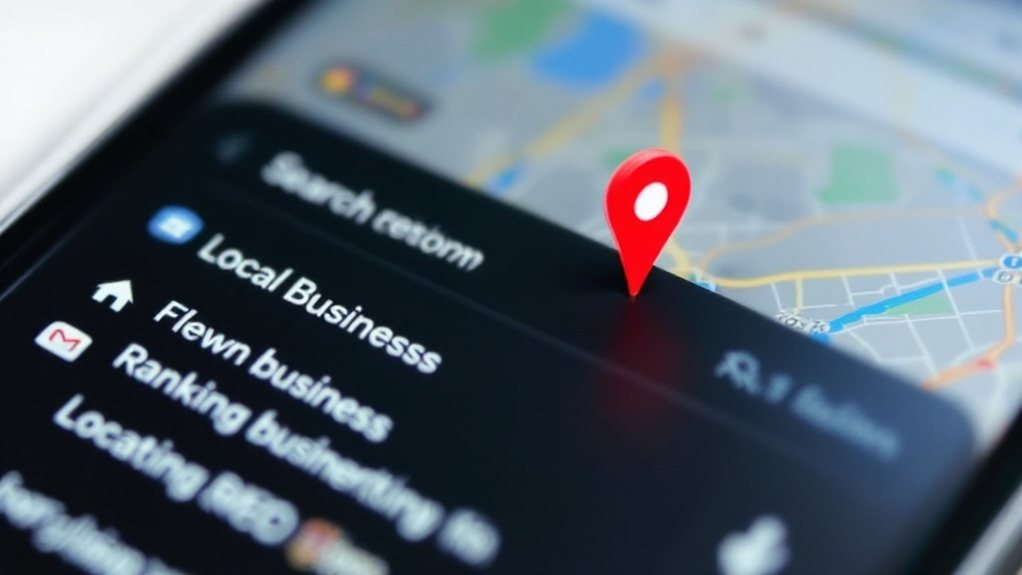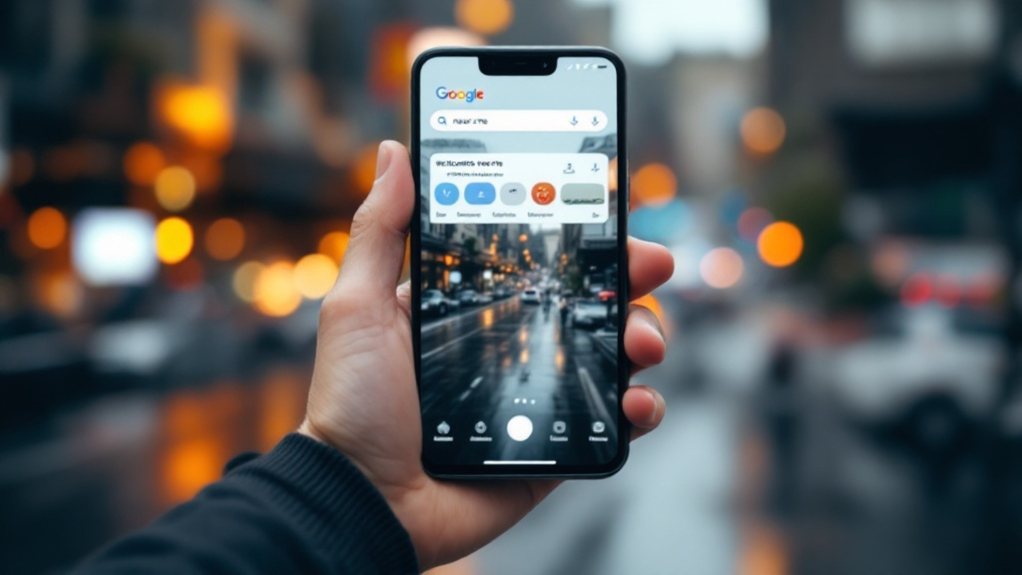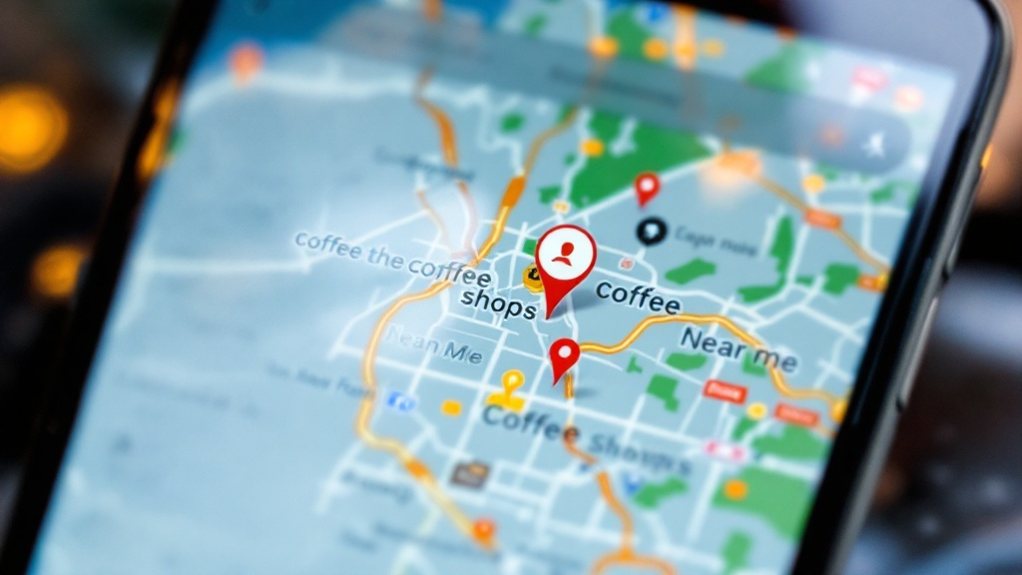Proximity is a key ranking factor for 'near me' searches, as Google prioritizes businesses close to the user. With over 60% of searches on mobile, consumers rely on smartphones to find nearby options. Optimizing your Google Business Profile, using location-based keywords, and ensuring consistent listings can boost your visibility. By understanding how proximity and mobile search behavior impact 'near me' SEO, you can gain a significant advantage over competitors. To dive deeper into leveraging these strategies…
Proximity as a Ranking Factor in Local Search

What exactly is proximity, and how does it influence local search rankings? Proximity in local search refers to the physical distance between a business and the user conducting a search. Google prioritizes results based on relevance, distance, and prominence for local searches. Businesses closer to the searcher generally rank higher. This is especially true in urban areas with higher competition. Google measures distance using data about the user's location, even if a specific location isn't provided. Location-specific queries and Google Maps integration further emphasize the role of proximity. However, businesses must ensure other SEO factors, like content quality and reviews, remain strong to counterbalance proximity challenges in competitive markets.
Leveraging Proximity for Business Visibility

As "near me" searches have skyrocketed by over 500% in 2023, leveraging proximity has become crucial for businesses seeking enhanced visibility in local search. With approximately one-third to 46% of Google searches having local intent, optimizing your Google Business Profile can drive a 61% increase in direct calls. Businesses with physical locations close to their target audience benefit from proximity bias, improving search rankings. Proximity is one of the most influential factors in the local map pack. Additionally, proximity targeting delivers personalized messages to potential customers nearby, boosting brand awareness, foot traffic, and customer loyalty. Analyze location data to optimize your marketing strategies and ensure your website and GBP are well-optimized to leverage proximity and other SEO factors effectively.
Optimizing for Proximity in SEO

To optimize your website for proximity in SEO, you must understand the nuances of how Google's algorithm considers location. Proximity is a key ranking factor in Google's search algorithm, influencing the relevance and visibility of your content for location-based queries. By leveraging proximity search operators, location-based queries, and your Google Business Profile, you can enhance visibility for localized searches. Additionally, incorporating location-specific keywords in your social media and image optimization can further boost your proximity-based ranking. Ensure your mobile content is optimized to target users conducting localized searches on the go.
| Proximity Search Techniques | Benefits |
|---|---|
| Proximity Search Operators | Refine search queries and enhance local SEO |
| Location-Based Queries | Capture user intent focused on nearby services |
| Google Business Profile | Improve Google's matching of businesses to localized searches |
| Social & Image Optimization | Boost proximity-based visibility |
The Rise of 'Near Me' Searches on Mobile
The rise of mobile search has transformed the way consumers find local businesses. Mobile devices now account for 63% of Google searches, driving the surge in "near me" queries. Smartphones have become essential shopping tools, with 69% of shoppers using them for research. Advances in mobile technology have made it easier to find nearby options without needing to enter a zip code. As mobile-first indexing prioritizes responsive websites, businesses must optimize for "near me" SEO to boost their visibility. The desire to purchase is so strong with near-me searches represent a significant opportunity for local businesses to connect with ready-to-act customers.
Mobile Search Trends and Purchase Intent
The rise of mobile "near me" searches reflects a growing consumer demand for immediate, location-based solutions. Customers with purchase intent now turn to their smartphones to discover and evaluate nearby businesses, often taking action within a day. Over 60% of searches come from mobile devices, emphasizing the importance of mobile optimization. Optimizing your online presence for mobile search is crucial to capturing these ready-to-buy consumers.
Surge in Mobile "Near Me" Searches
As the surge in "near me" search queries continues, you've likely experienced this trend firsthand. With a recent 136% increase, these location-based searches now dominate nearly half of all Google queries, emphasizing the importance of proximity in search results. The majority of these searches occur on mobile devices, underscoring the need for mobile-friendly content. Businesses failing to appear in local search results risk losing visibility and credibility. This growth trend is expected to continue, driven by consumers' demand for immediate access to products and services. Mobile devices accounted for over half of all organic search engine visits in the United States. Optimizing your mobile presence, from load times to localized keywords, is crucial to capitalize on this shift in user behavior.
Mobile Searches Fuel Purchase Demand
Mobile searches not only account for the majority of Google queries, but they also indicate a strong intent to purchase. With 80% of local searches leading to conversions and 78% resulting in offline purchases, local businesses can capitalize on this trend. 30%-50% of all Google searches are local, according to Google. Consumers increasingly rely on mobile devices to research products, find business locations, and make purchasing decisions. The convenience and speed of mobile search make it a powerful driver of sales, especially for brick-and-mortar stores. To succeed, businesses must optimize their mobile experiences, including responsive design, fast loading speeds, and local SEO. By focusing on the mobile-driven purchase intent, companies can maximize their visibility and conversion rates.
Crafting Location-Specific Landing Pages
To optimize your landing pages, focus on incorporating local keywords, utilizing Google My Business features, and tailoring content to local user needs. Proximity is a crucial local SEO ranking factor Expanding your service coverage with location-specific pages can boost your visibility in proximity-based searches and drive more qualified leads to your business.
Optimize Landing Pages
Crafting location-specific landing pages is a crucial step in optimizing your local search engine optimization (SEO) strategy. Incorporate local keywords and content to enhance relevance for nearby searches. Design engaging, user-centric pages with local imagery, clear calls-to-action, and mobile-friendliness. Leverage schema markup and embedded maps to showcase your business's proximity and services. Ensure consistent NAP information, integrate with local social profiles, and gather positive reviews to build authority. Optimize technical elements like title tags, meta descriptions, and content structure to support your local SEO efforts. Backlinks from local directories are crucial for improving your standing in local search results. By addressing these key factors, you can create highly effective location-specific landing pages that attract and convert local customers.
Expand Service Coverage
Why not expand your service coverage by crafting location-specific landing pages? By targeting geographic areas, you can bypass high competition and focus on local keywords to increase visibility in search results. Local SEO is a subset of SEO that focuses on improving a business's visibility in local search results. Reinforcing NAP consistency across these pages will boost your business credibility and local SEO efforts. Leveraging relevant local content and highlighting attractions can foster engagement with your target audience. Plus, optimizing these pages for mobile will ensure you capitalize on the dominance of mobile searches for local services. Integrating Google Maps can further enhance the user experience. Expand your reach and connect with local customers through strategic location-based landing pages.
Enhancing Local Credibility With Structured Data
How can you enhance your local credibility with structured data? By utilizing structured data, you can boost your local SEO visibility and showcase critical business details directly in search results. This helps build trust with potential customers and improves your chances of converting leads.
Consider the following structured data types for local businesses:
| Schema Type | Purpose |
|---|---|
| LocalBusiness | Provides essential business details |
| Restaurant | Highlights menu and reservation info |
| GeoCoordinates | Pinpoints precise business location |
| Event | Showcases specific events and activities |
| Review | Displays customer ratings and feedback |
Integrating structured data empowers AI systems to understand your business context, delivering accurate location-based information and rich snippets that attract more clicks.
Importance of Consistent Business Listings
As a local business, maintaining consistent listings across online platforms is crucial for your visibility and credibility. Consistent business listings, which include your name, address, phone number, and other key details, help verify your legitimacy to search engines. This, in turn, boosts your local search rankings, making it easier for nearby customers to find you. Accurate listings also foster trust, as customers can confidently access your correct business information. By keeping your listings consistent, you'll differentiate yourself from competitors and enhance your overall online presence. Regularly monitoring and updating your listings is an essential part of an effective local SEO strategy.
Leveraging Google Business Profiles for 'Near Me' SEO
Optimizing your Google Business Profile is key to boosting your visibility in local search results. Take advantage of the profile's analytics to monitor and improve your local SEO efforts. Ensure your business details are accurate, leverage strategic keywords, and regularly update your profile to maintain relevance.
Accurate Business Details
Google Business Profiles play a crucial role in "near me" searches, as they provide accurate business details to search engines. Consistent name, address, and phone number (NAP) across all online platforms reduces errors and misdirected traffic. Search engines prioritize businesses with consistent information, as inconsistencies can lead to lower visibility in local search results. Accurate NAP also helps in better targeting of local SEO efforts. Besides NAP, business hours and categories are essential for relevance, while high-quality images and consistent information across platforms enhance search engine trust in the business data.
Optimizing Business Profiles
To succeed in "near me" searches, you must optimize your Google Business Profile. A complete and accurate profile provides the necessary information for strong local rankings. Ensure your business hours and contact details are up-to-date. Choose the right categories to showcase your relevance. Add photos and highlight key amenities. Positive reviews significantly boost your rankings, so encourage customer feedback. Supplement your profile with schema markup to enhance visibility in search results. Maintain consistency across your online listings to build trust and authority. With a well-optimized Google Business Profile, you'll position your business for success in proximity-based local searches.
Utilizing Business Insights
Harnessing the power of Google Business Profiles can significantly boost your "near me" SEO efforts. Profiles enhance your local visibility, with 46% of searches having local intent. Optimize your profile to capitalize on mobile searches, as proximity is a key ranking factor. Positioned near searchers, your business can appear in the coveted map pack. Positive reviews and ratings build trust, further improving your local search rankings. Stay ahead of the competition by leveraging these insights. Consistently update your profile to ensure accurate business information across the web. Prioritize your "near me" SEO strategy to capture high-intent local searches and drive more conversions.
Bridging the Gap Between 'Near Me' Searches and Conversions
Although "near me" searches have skyrocketed in recent years, many businesses struggle to effectively convert these high-intent leads. In fact, nearly half of all Google searches are for local businesses, and 28% of "near me" searches lead to a purchase. To capitalize on this opportunity, focus on optimizing your mobile presence. Ensure your Google Business Profile is complete and consistent with your online NAP details. Leverage location-specific keywords, user reviews, and photos to boost your credibility and visibility. By bridging the gap between "near me" searches and conversions, you can drive more in-store traffic and offline sales for your local business.
